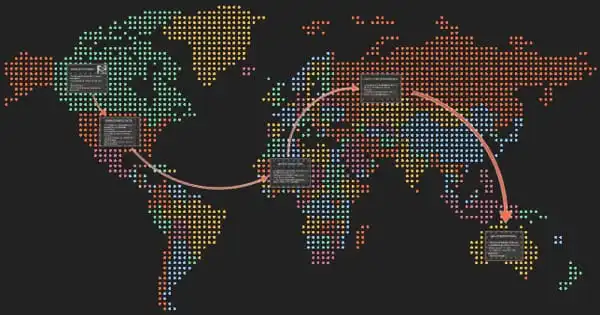The term “brain drain” refers to the movement of highly skilled workers from one country to another. “A society that cannot place the highest value on knowledge and its acquisition, inevitably alienates itself from creating, transmitting, and using knowledge,” said Shri P.N. Haksar. Alienation contributes to apparent brain drain, which results in migration, and invisible brain drain, which results in a loss of morale and creativity among those who remain in India. Both visible and unseen brain drain results in significant national losses that cannot be quantified.
According to a UN report, a brain drain of highly skilled professionals to well-paid jobs in the first world costs Asia billions of dollars each year, but the traffic is not all one way. According to the United Nations Development Programme’s (UNDP) Human Development Report 2001, India loses $2 billion in resources each year due to the emigration of computer professionals to the United States alone.
These emigrants frequently achieve significant professional and economic success in their new home. In 1998, for example, Indian engineers were heading over 775 technological companies in California’s Silicon Valley, accounting for $3.6 billion in sales and 16,600 employees. However, the relationships between these Non-Resident Indians (NRIs) and their home country were usually limited to holiday trips.
Policymakers in India now have the potential to turn brain drain from a scourge into an asset. Changes in the structure of competition in the Information Technology (IT) industries have not only allowed for the rise of software development in India but also the prospect of economic leapfrogging not previously feasible. In many regions of the world, “brain drain” is giving way to “brain circulation,” as smart immigrants who have studied and worked abroad return home to pursue potential prospects. Engineers and other professionals who return home, whether temporarily or permanently, bring not only technology and capital but also administrative and institutional know-how to formerly marginal regions.
Policymakers in India must learn from Taiwan’s experience, where brain circulation was vital to the country’s transformation from a peripheral supplier of cheap labor to a global leader in IT manufacturing. The challenge for India’s Information Technology (IT) sector is to modernize the software business, which currently focuses on low-value-added services for export markets. As in Taiwan, Indian officials might speed up the process of industrial upgrading by incentivizing engineers to return to India as policy consultants as well as investors, entrepreneurs, and managers. It should be clear that this is merely the first step for India.
External linkages must be expanded to maintain competitiveness in a global economy. However, this must be complemented by deliberate efforts to build the domestic market in order for the benefits of the new industries to contribute to a larger process of economic development.
“The first and main concern is brain drain,” he added, adding that it needed to be reversed. According to Nasscom, 25,000 people have returned to India in the previous three years, with 90% of them being software professionals. “This tendency has barely begun,” Mr. Mashelkar remarked. India must transform itself into a land of opportunities. “We cannot be a land of ideas without also being a place of possibilities,” he explained.
Second, India must aggressively explore public-private partnerships, he added, citing 39 government-owned software technology parks that house 3,500 enterprises and account for 80% of IT exports. With reputable employers, great working conditions, enhanced telecommunications, appealing incomes, and India’s current entrepreneurial climate, young professionals and technocrats are returning home and building business links.
Chetan Raghavan is overjoyed. He’s landed an “amazing” job. A competitive salary, a corporate car, and a luxurious three-bedroom apartment are just a few of the benefits. But what excites this California resident the most is the possibility of soon being surrounded by family and friends. He’s relocating to Bangalore. “We always knew we’d go back one day,” Raghavan adds his wife, Sarita, nodding in accord. The Raghavans are giving up their American dream in exchange for a one-way trip to India. They aren’t the only ones.
According to a survey conducted by the Public Policy Institute of California, 40% of foreign-born respondents would contemplate returning to their home countries. According to Anna Lee Saxenian, a professor at the University of California at Berkeley, the so-called brain drain from India has evolved into a more sophisticated two-way process of “brain circulation” linking California’s renowned Silicon Valley to urban centers in India. Saxenian discovered that roughly three-fourths of the primarily Indian and Chinese immigrants interviewed knew one to ten immigrant professionals who had gone home.
“This ‘brain circulation’ is expected to spread in the near future, with significant implications for greater economic development in other nations,” she says. There are economic opportunities in the United States, but there also policy difficulties to overcome. Trade, immigration, and intellectual property rules are all based on more limited one-way flows of skills and technology, primarily within multinational firms. Today, there is a new reality.”
According to Sushil Bhikhchandani, the Agoura, California-based chief of operations at, an employment portal that offers jobs in India, the movement of Indian expats to India is a “new phenomena.” “The folks who are returning are primarily those who were either laid off from their positions in the United States or who had planned to return in a few years but chose to accelerate their plans,” he says.
According to Bhikhchandani, three elements have made India appealing. “Availability of good employees in India—from computer scientists and engineers to call center personnel—at a fraction of the salary of comparable US employees; improved telecommunications, making it easier for US companies to do some of the work offshore; and tremendous competitive pressure to cut costs.”
Karthik Sundaram, the managing editor of California-based Silicon India, organized a series of back-to-India job fairs last year. “Many Indians living in America dream of returning to India but they are nervous and don’t know how to go about making that transition,” Sundaram says.
He gave a place for people to explore opportunities as well as air apprehensions through the fairs. The expo, which was intended to be a two-city event, quickly extended to more cities across the U.S. desire in returning home is matched by U.S. corporations’ eagerness to relocate work elsewhere. Multinational corporations such as Microsoft, Intel, and Oracle Corporation are actively seeking English Essays 19 talent to manage their Indian operations. “They no longer regard their operations in India as a back office,” Sundaram says.
Rafiq Dossani, head of Stanford University’s South Asia Initiative, observes that the acceleration of outsourcing or business process offshoring is connected with enterprises’ increasing readiness to outsource what were previously considered core activities. “It is notable that a considerable number of service activities may go offshore because it was originally anticipated that service jobs would be the future growth area for developed country economies,” he says in a working paper. While adapting to the American economic environment, Indian entrepreneurs in the United States have kept close contacts with India. According to Saxenian, these links are contributing to the expansion of global corporate networks and promoting economic development in cities such as Bangalore.
Bangalore is at the top of the list of desired locations for those considering a return trip. The following cities are Hyderabad and Pune. One of the reasons Bangalore is a popular tourist destination is the state-of-the-art Intel campus. Intel provides a competitive salary, staff perks, and stock options comparable to those offered at its headquarters in the United States.
Arjun Batra’s job is to make certain that suitable people relocate to India. “I cherish my ancestry and am determined to aid people for whom the prospects to return to India are right,” says Batra, business development and project incubation manager at Intel India Development Center in Santa Clara, California.
Most people returning to India choose jobs with American corporations over outsourced contact center duties.” However, according to Bhikhchandani, outsourcing by US corporations is “the most important component” in a person’s decision to return to India. “At the same time, several sections of India have a tremendously entrepreneurial climate, nurtured primarily by Indian businessmen.” Being close to parents and grandparents is a top priority for many young families considering a return to India. According to Batra, relocating operations to India means, among other things, cost savings because costs are cheaper in India.
Causes for Brain Drain Are we able to provide them with suitable jobs according to their abilities?
What propels them towards the other countries? Dr C.V. Raman was compelled to join IA & AS for a few years because he couldn’t get a good scientist job. A plethora of causes ranging from attraction towards the foreign country to monetary benefits, is cited for brain drain. Monetary gains and good jobs of their satisfaction are the main reasons for the brain drain. The highly educated find no place or desire respect in the Indian panorama, they go out of the country, earn good money, and respectful recognition not only in a foreign country but in our country as well after returning. Take the case of Kalpana Chawla who died in space. What she could achieve in the USA, was impossible to achieve in India, whatever caliber she might have possessed? Who so even has gone to the west for studies and remained there even for five or six years, finds it almost impossible to settle in Indian conditions.
Our system does not allow lateral entry, every post is tailor-made, no triangle can fit as a square, and no hexagon as a triangle. The rigidity in the system does not allow people to return to India from abroad. The salary structure is also rigid and has no place for extra increments to the talented.
Aside from the smaller wage package, working conditions in India are not uniform and conducive to advancement. High-level technocrats are frustrated by bureaucratic constraints and red-tapism. A technocrat in India discovers while flipping through a magazine, that Dr. Reddy has already patented some medicine in Canada, despite the fact that he applied six months ago in India, but alas! the tedious and burdensome procedure in India took a long time.
Changed Scenario: For many years, students and professionals from India’s educational system have traveled overseas in pursuit of new experiences. It is now India’s turn to reverse the “brain drain,” with the Ministry of Human Resource Development launching a strategic plan to “extensively internationalize Indian education.” As part of the overall initiative, the Ministry today established an educational portal at India International Centre with the support of Educational Consultants India Limited.
“What we want is to provide comprehensive information at the fingertips of students living abroad,” said Medury, Chairman of, adding, “We want to operate as long-term career guides to overseas students, not just a one-time facility.” This portal now includes over 161 educational institutions such as Indian Institutes of Technology (IITs), Indian Institutes of Management (IIMs), Regional Engineering Colleges, Madras University, Pune University, and others.
The website takes a learner on an educational tour of India. The webpage begins by explaining why students should choose India as their academic location. The portal, which lists “great educational facilities in India,” emphasizes the cost-effective aspect of Indian education, its international acceptability and recognition, and the fact that “India is a democratic country that provides a safe and stable political climate.”
According to the Charged Affairs, Embassy of Rwanda, Nyilinkindi, “the standard of Indian education is quite high, especially in information technology, and is very affordable, at roughly 4000 dollars per year.” Syrian Ambassador to India, Al-Khayer, on the other hand, stated, “Being a prosperous nation, we can afford to send our students to Western countries.” We choose India, however, due of its high academic standards and because we share the same culture.”
According to Mr. Maharaj Krishen Kaw, Secretary of Secondary and Higher Secondary Education, the portal this year is aimed towards students from African countries as well as Mauritius, the Gulf area, Malaysia, and Indonesia. The action is being conducted in the “broader diplomatic interest of stronger relations with these countries. We have also asked universities to have a 15% quota reserved for foreign students, with a priority given to persons of Indian heritage,” he says.
However, a few academics have issued a word of caution. “We shouldn’t get too excited about the site’s creation, thinking it will bring a flood of foreign students to India. Aggressive advertising of this portal abroad is required,” warned Mr. Syed Shahid Mandi, Vice-Chancellor of Jamia Milia Islamia.
“If Indians return with fair expectations, they will not be disappointed,” Susheel Chandra says. “There is a possibility that people will not like the new scenario, but the decision to return should not be written in stone; you’ve got to keep your options open.”
Many of those considering a return are green card holders or residents of the United States. They have the choice of remaining in both realms. Those on H-1B visas do not have the same luxury. “I want to return since I never planned on staying out for the rest of my life,” says Shalini Roy, a software programmer in New Jersey and an H-18 visa holder. This isn’t your house.”
“Not everyone agrees with Roy’s point of view. “Many individuals are returning to India out of desperation,” Chandra adds. “If they are provided a job in the United States, they will not return.” 50 percent of the resumes were for positions in the United States. Twenty percent of those polled were serious about returning to India. Is India simply the lesser of two evils in light of the current status of the US economy?
Despite the fact that the US economy is strengthening, there has been relatively little job creation. The main reason people are returning is that good employees are now available in India. Even if the US economy improves, the elements that make India appear attractive will remain. “In the end, people will travel where there are suitable jobs available, and there are exciting new prospects sprouting up in India, so the trend is in reverse gear.”
















